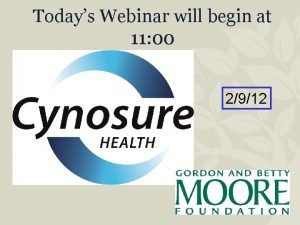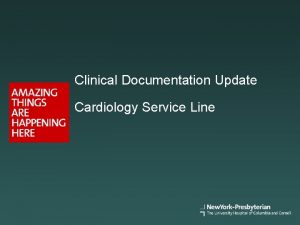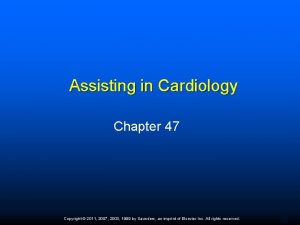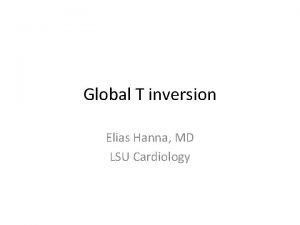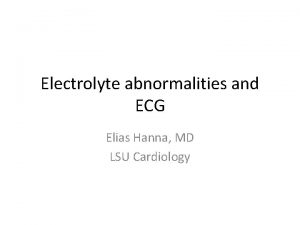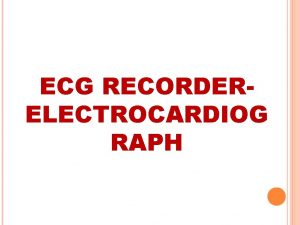Elias Hanna MD Cardiology ECG 1 This ECG












- Slides: 12

Elias Hanna, MD, Cardiology ECG 1 This ECG is read as normal by the computer

Q wave that is part of a QR or QRS complex is abnormal if: *wide > 1 small box *or if present in V 1 -V 3 to the right of the transition zone, regardless of how small it is. Exception: Wide Q may be normally seen in leads III or a. VL in an isolated fashion QS pattern is abnormal in all leads except III, and leads V 1 +/- V 2

ECG 1 On this ECG, there is an abnormal Q in II, III, a. VF diagnostic and specific for an inferior infarct of indeterminate age Although Q is not deep, it is wide > 1 box, signifying a pathological Q. Had the wide Q been isolated in lead III, this ECG would be considered normal Echo confirmed the old inferior infarct

ECG 2 56 yom, presents 14 hrs after CP onset.

ECG 2

ECG 2 shows minimal residual ST elevation with a narrow tiny q in leads V 3 -V 4 and post-ischemic T-wave abnormality (not true Wellens since there are Qs). Q wave of any size, when seen in the precordial leads before the transition zone as part of a qr. S complex (i. e. , qr. S before the transition zone), is abnormal Q and is 100% indicative of MI. This is basically late STEMI presentation at a time where ST elevation is resolving and Q waves/T inversion appeared.

Q wave that is part of a QR or QRS complex is abnormal if: *wide > 1 small box *or if present in V 1 -V 3 to the right of the transition zone, regardless of how small it is. Exception: Wide Q may be seen in leads III or a. VL in an isolated fashion QS pattern is abnormal in all leads except III, and leads V 1 +/- V 2

ECG 3 Inferior Q and anterolateral QS pattern (wide monophasic Q, arrows). QS in leads V 1 -V 2 may be normal, but not in V 3 -V 6

Q wave that is part of a QR or QRS complex is abnormal if: *wide > 1 small box *or if present in V 1 -V 3 to the right of the transition zone, regardless of how small it is. Exception: Wide Q may be seen in leads III or a. VL in an isolated fashion QS pattern is abnormal in all leads except III, and leads V 1 +/- V 2

On this ECG, QS is seen in V 1 -V 2, small R wave is seen in V 3 -V 6: as opposed to QS extending to V 3 or beyond, QS limited to V 1 or V 2 is not definitely an anterior MI. Only 20% of pts with QS in V 1 -V 2 without other abnormalities on the ECG have anterior MI.

ECG 4 Inferior and posterior MI. Wide (> 1 small box) +/- tall R in V 1 or V 2 is indicative of posterior Q-wave MI

Summary: Abnormal Q= *Q wider > 1 box (0. 04 sec) and deeper > 1 box in 2 contiguous leads *Q of any width before the precordial transition zone (i. e. , V 1 -V 3) *Q may have a QS shape, which is a very wide and deep Q wave usually indicative of MI, except in leads III or V 1 +/ -V 2 where it may be represent a normal variant *Wide +/- tall R in V 1 or V 2 indicates posterior MI
 Qs complex
Qs complex Enloe cardiology
Enloe cardiology Accp cardiology prn
Accp cardiology prn Muse cardiology
Muse cardiology Westcliffe cardiology shipley
Westcliffe cardiology shipley Inculprate
Inculprate Acc sports cardiology
Acc sports cardiology Craig ainsworth cardiology
Craig ainsworth cardiology Clinical documentation improvement for cardiology
Clinical documentation improvement for cardiology Cath lab report example
Cath lab report example Service line management
Service line management Hall-garcia cardiology associates
Hall-garcia cardiology associates Cardiology procedures chapter 47
Cardiology procedures chapter 47

